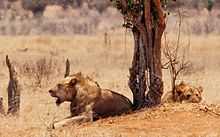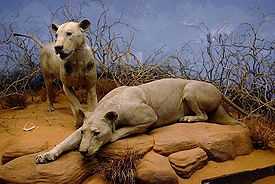Tsavo lion

Tsavo lions (Panthera leo nubica) are a distinct variety of lion living around the Tsavo River in the Tsavo National Park in Kenya. Tsavo males are notable for their lack of mane and smooth pelt, their size, and that they actively participate in hunting. Tsavo males have been known as man-eaters, particularly involving an incident during the building of the Uganda Railway in the late 19th century.
Tsavo males and prides

Males of the Tsavo prides are usually larger than other male lions, and actively participate in hunting. It has been hypothesized that this is due to a lack of mane and the scarce food supply at the Tsavo East National Park, a region dominated by flat, dry plains.
Tsavo prides are unique in that they frequently have only a single male lion, whereas most lion prides have two to eight (usually related) males. Tsavo prides also tend to be larger overall, with an average of 7 to 8 adult females in each group.[1]
Maneless males
The male lions generally do not have a mane, though colouration and thickness may vary. There are several theories as to why this is. One is that mane development is closely tied to climate because its presence significantly reduces heat loss.[2] Another theory is that manelessness is an adaptation to the thorny vegetation of the Tsavo area in which a mane might hinder hunting. Tsavo males may have heightened levels of testosterone, which could explain both the Tsavo lion's manelessness and its reputation for aggression.
Attack incidents

Two of these lions are known as the Tsavo man-eaters; they attacked workers on the Kenya-Uganda Railway in 1898. They killed more than 35 people[3] in less than a year before being found and killed by Colonel John Patterson.
Status
There are about 675 lions in the Amboseli-Tsavo ecosystem. A few hundred more, which show partly similar phenotypes live in the north of Kenya, for example, at Samburu and Meru. Lions and their prey are officially protected in Tsavo, but they are regularly killed by members of the local population. Between 2001 and 2006 more than 100 lions have been killed in the Amboseli-Tsavo ecosystem. The poachers usually do not face serious consequences, although the game wardens who arrest offenders have been punished by the community.[4]
National Geographic
An article about lions of the Tsavo area appeared in the April 2002 issue of the National Geographic magazine. The article discusses some of the unique challenges to survival that Tsavo lions face. The controversial issue as to why some Tsavo lions lack manes is explored by Peyton West of the Lion Research Institute.
See also
Notes
- ↑ Borzo, Greg (2002). "Unique social system found in famous Tsavo lions". EurekAlert.
- ↑ Call the Hair Club for Lions. The Field Museum.
- ↑ Estimates of the people killed vary; Patterson stated 135; see discussion: Modern research.
- ↑ Frank, L., Maclennan, S., Hazzah, L., Hill, T., & Bonham, R. (2006). Lion Killing in the Amboseli-Tsavo Ecosystem, 2001-2006, and its Implications for Kenya’s Lion Population. PDF Living with Lions, Nairobi, Kenya, 9.
References
- Caputo, Philip (April 2002). "Maneless in Tsavo". National Geographic: 40–53. Retrieved 23 February 2013.
- West, Peyton M.; Packer, Craig (23 August 2002). "Sexual Selection, Temperature, and the Lion's Mane". Science 297 (5585): 1339–1343. doi:10.1126/science.1073257. ISSN 0036-8075. PMID 12193785. Retrieved 23 February 2013.
- Kays, Roland W.; Patterson, Bruce D. (1 March 2002). "Mane variation in African lions and its social correlates". Canadian Journal of Zoology 80 (3): 471–478. doi:10.1139/z02-024. ISSN 0008-4301. Retrieved 23 February 2013.
- Patterson, Bruce D. (2004). The Lions of Tsavo: Exploring the Legacy of Africa's Notorious Man-eaters. New York: McGraw-Hill. ISBN 0-07-136333-5. Retrieved 23 February 2013.